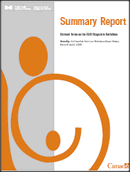Common menu bar links
Institutional links
Diseases & Conditions
Health & Safety
Research & Statistics
Agency Information
Search Box
E-mail this page
Summary Report
National Forum on the FASD Diagnostic Guidelines
Hosted by: the Canadian Centre on Substance
Abuse Ottawa,
March 8 and 9, 2005
Table of Contents
- Introduction
1.1 Context and Purpose
1.2 In Attendance
1.3 About This Report - The Program and Discussion
Highlights
2.1 Opening Remarks
2.2 Background on Development of the Guidelines
2.3 Overview of the Diagnostic Guidelines
2.4 Small Group Discussion
2.5 Overview of Current Training Initiatives
2.6 Data Collection and Monitoring System
2.7 Afternoon Opening Remarks
2.8 Priority-setting Exercise - Closing Remarks
Appendices
Appendix 1: Agenda
Appendix 2: Invitation and Participant Lists
Appendix 3: Sub-Committee Membership
Appendix 4: List of Ranked Priorities
The opinions expressed in this paper are those of the authors and do not necessarily represent those of their affiliations or the Public Health Agency of Canada.
Mission:To promote and protect the health of Canadians
through leadership, partnership, innovation and action in public
health.
Vision: Healthy Canadians and communities in a healthier
world.
Public Health Agency of Canada
This publication can also be made available in/on computer diskette/large print/audio-cassette/Braille upon request.
For further information or to obtain additional copies, please
contact:
Publications
Health Canada
Ottawa, Ontario K1A 0K9
Tel.: (613) 954-5995
Fax: (613) 941-5366
E-Mail : info@hc-sc.gc.ca
© Her Majesty the Queen in Right of Canada, 2006
Executive Summary
The purpose of the National Forum on the FASD (fetal alcohol spectrum disorder) Diagnostic Guidelines was to identify next steps for the Guidelines, especially in the area of training supports required and ideas for a national data collection system. Participants strongly supported the process of Guidelines development, for the potential that the Guidelines hold for standardized diagnosis across Canada and for the development of a national data collection system that will eventually describe the incidence and prevalence of FASD in Canada.
Participants encouraged national leadership and coordination on the Guidelines as the dissemination plan is formulated and implemented across Canada. They also noted that many issues need to be addressed for the Guidelines to be fully accepted and used.
Participants raised several key issues in the large group discussions, distinct from the main themes of the Forum. Several expressed the need to ensure quality of life for those who have FASD and those who support them. They indicated that quality of life can be compromised for those with FASD and that sometimes this reality is overlooked or forgotten in discussions. Participants alluded to the lack of diagnostic capacity, especially in smaller areas, the dilemma of obtaining a diagnosis and then not having supports available, and the ongoing difficulty of not receiving supports in general, particularly for families that are overwhelmed with caring for persons with FASD.
Other participants noted the lack of diagnostic capacity for adults and the great need for ensuring that diagnosis efforts are not limited to the young. In addition, they noted that if diagnosis is not made early on, secondary disabilities that emerge during early adulthood can cause major difficulties.
With regard to acceptance of the Guidelines within different disciplines, participants stated that particular attention needs to be paid to how the Guidelines are disseminated to the addiction treatment/intervention workforce. It is critical that this group of professionals/paraprofessionals receive training that addresses their role vis-à-vis diagnosis. Next steps must include training supports designed to ensure that those using the Guidelines have all the knowledge and skills necessary to use them most effectively.
Participants also identified the need to validate the Guidelines with various cultural groups.
Several participants urged that the Guidelines be viewed as a living document: that a process be put in place to ensure they remain current, and that they reflect the best practices and knowledge available as the field matures and learns from its experience. It is important that the responsibility for ensuring this be vested in a specific organization, or else it will not occur.
There is a need to ensure ongoing validation of the Guidelines, including a process to collect data/evidence to demonstrate that the Guidelines are being used for their intended purposes and expected results.
Although the Forum did not address in any detail the needs and concerns of affected individuals and families, several participants recognized that it is vitally important to remember these constituents in any dissemination activity. They urged the Canadian Centre on Substance Abuse and the Public Health Agency of Canada to keep families and community support "top-of-mind" in considering next steps.
Finally, the issue of leadership for next steps arose many times during the Forum, at times solicited through discussion and at other times through spontaneous comments. Participants agreed that national leadership for dissemination is critical. Many concurred that the CCSA mandate is compatible with leading dissemination and bringing partners to the table that have complementary roles to support various aspects of dissemination. The goal of dissemination is to ensure the greatest likelihood of uptake across the country, along with training and data collection.
The top five priorities that emerged from the Forum were:
- Disseminate the Guidelines and progress to professional and non-professional groups.
- Develop, establish, implement, evaluate and maintain standardized training.
- Create and obtain funding.
- Establish universal access to improve/maintain/sustain expertise in all provinces/territories/First Nations/Inuit/Métis.
- Establish data collection concurrent with the dissemination of the Guidelines.
Participants confirmed that the event was a good use of time, that the process was productive and that what remained was to turn ideas into action as quickly as possible.


